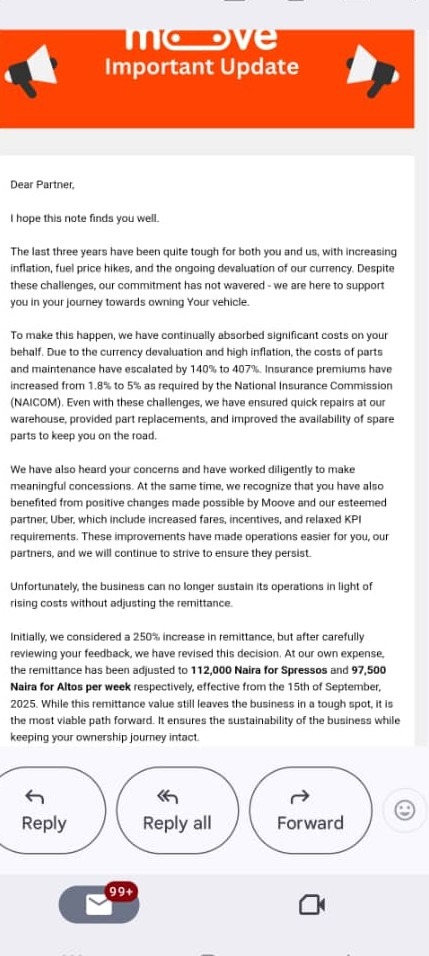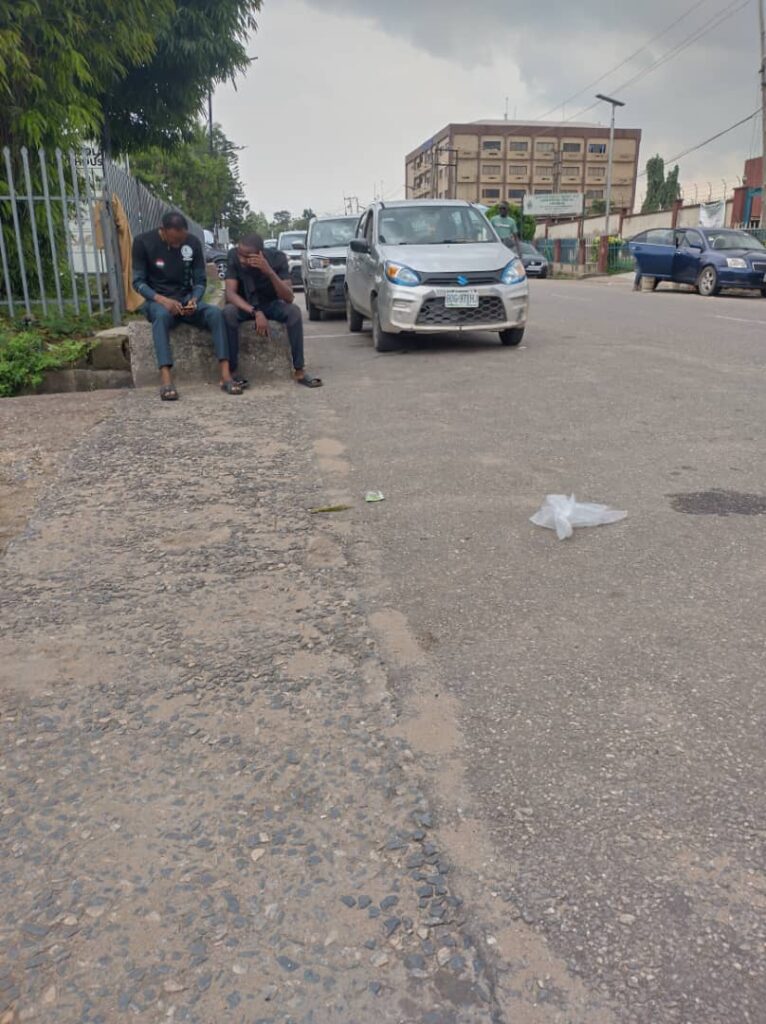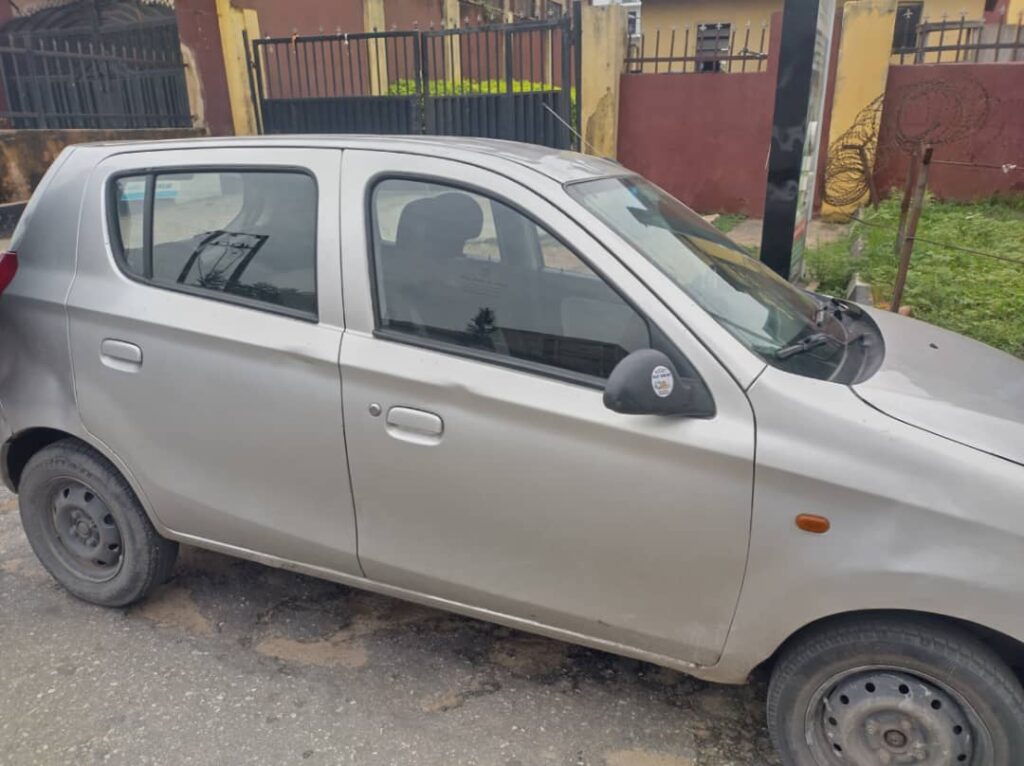In the stifling humidity of a Lagos traffic jam, the glovebox of Christian Ovie’s Suzuki S-Presso rattled with a secret he wasn’t meant to find. Ovie realised the “fresh start” he had been sold in 2024 was a fabrication. He had signed a 24-month financing deal with Moove, Africa’s hottest mobility fintech, under the promise of a new vehicle. Instead, the odometer and the documents confirmed he had inherited a ghost—a recycled asset with a hidden history.
Ovie is one of thousands of drivers navigating the ecosystem of Moove, a startup backed by heavyweights like Uber and the sovereign wealth fund Mubadala. With the company inching toward a $1 billion valuation, the pitch is seductive: democratize vehicle ownership in a market where credit is scarce. “Moove was the only opportunity, and I took it, hoping it would be hire-purchase and not lead to frustration,” Ovie explained, his voice tight with distress. But for drivers like him, the math has quickly turned predatory.
Instead of a path to ownership, Ovie faces a financial trap. He is allegedly on the hook for ₦20 million ($13,740)—nearly double the market rate—for a used vehicle laden with the invisible baggage of previous users. After paying a ₦100,000 ($68.70) deposit and waiting months for a new car that never arrived, Ovie resolved to accept a refurbished unit to “continue where the previous driver stopped.” He had already paid ₦2.2 million ($1511) in daily remittances when the terms aggressively shifted.
Citing Nigeria’s blistering inflation, rising fuel costs, and currency devaluation, Moove reportedly hiked Ovie’s daily remittance from ₦9,400 to ₦18,700. Furthermore, the company unilaterally revised the agreement, adding three years and two months to his repayment term. “They are insisting I pay ₦18,700 daily for the next three years—amounting to ₦20 million,” Ovie says.

This discrepancy reveals a dark engine at the heart of the “drive-to-own” model: Asset Churn. When a driver defaults, crushed by operating costs, the car isn’t retired; it is stripped and recycled for the next applicant. For Moove, it is a way to hedge against volatility. For Ovie, it means driving a vehicle that has already failed a predecessor, paying a premium for a new car while servicing the debt of a ghost.
Moove declined to comment on any part of this story.
**********
“People who hear our story think we were blind when we signed the contract. Honestly speaking, we were not blind,” Seun Adeyemi, a driver of a Suzuki Alto, told Condia.
“Instead, the strategy Moove put in place made sure there is nobody who will come for this car and not want to have it. They will definitely fall victim to the same thing we fell into.”
Adeyemi explained that many Moove drivers never got to sign any physical hardcopy contract.

Instead, drivers attended a two-session briefing, paid a deposit—₦50,000 ($34.35) for a Suzuki Alto or ₦100,000 ($68.70) for an S-Presso—and were handed a tablet to append their signatures digitally. A few new cars were on display during those sessions, Adeyemi said, as a decoy to convince drivers.
Moove operates two cars— the Suzuki Alto and Suzuki S-Presso. For the Alto, drivers are expected to follow up with a ₦7,000 daily remittance payment over four years, after which they would own the cars. For the S-Presso, drivers are expected to remit ₦9,400 for the same period. The daily asset payment fee was ostensibly all-inclusive, covering health insurance, vehicle maintenance, and comprehensive insurance.
That all-inclusive promise, drivers say, has evaporated. The allure of a new car was the attractive factor which drew drivers to Moove. Even that promise never saw daylight.
A failed promise
“There were no new cars at the beginning. As far back as three years ago. When I got my own car, the mileage was 46,000 kilometres. They (Moove) promised to get back to us on the vehicle loan book of how long the former driver had driven it and promised to deduct from the four years I am to spend,” Adeyemi explained.
Adeyemi’s predecessor had used the car for one year and two months. In September 2025, he had nearly clocked another year and was looking to complete the two-year target left when the company announced plans to double the daily remittance fee for the Alto to ₦16,250 and the S-Presso to ₦18,700, respectively.
“We have spent so much money repairing the cars ourselves. They (Moove) said if we cannot maintain it, we should park the car at the service centre in Ojota. Yet, we were met with more increments,” he added.
An overpriced asset?
There are varying valuations of Moove’s vehicular assets, especially in Nigeria.
In India, where Maruti Suzuki manufactures these units, a new S-Presso starts at approximately ₹349,900 (~₦5.7 million) while the Alto costs ₹3,69,900 (₦6,004,533), based on an exchange rate of about 1 INR to 16.22 NGN. On the open market, in Nigerian retail stores, local dealers like Autochek list the S-Presso for roughly ₦6.3 million ($4,337). Sources dating back to 2023 indicate Moove rents these vehicles out at a total valuation of roughly $25,450 (~₦11.7 million)—nearly double the local market value.
| Metric | Market Reality (Standard) | Moove Reality (Alleged) |
| Asset Price (Suzuki S-Presso) | ~₦11,000,000 (Cash Price) | ~₦20,000,000 (Financed Total) |
| Asset Status | New (0 Mileage) | “Refurbished” / Used (2021 Reg) |
| Loan Term | 48 Months (Standard) | 48 Months (Reset on Used Car) |
| Daily Remittance | N/A | ₦9,400 (Old) -> ₦18,700 (New) |
| Implied Interest Rate | ~24% (Bank Auto Loan) | >80% (Estimated Effective APR) |
The current S-Presso model has been associated with a number of failed crash tests. On the streets of Delhi, Suzuki Altos and S-Pressos have become a rarity after their production was discontinued for safety reasons in line with a mandatory airbags policy. The discontinuation also means that the S-Presso and Alto base variants would be priced higher, taking the vehicles out of reach a bit further.
“For me, I am using the third car. The first car they gave me lasted three weeks and packed up. We suspect that they repossess the car from a driver because they don’t have new cars again,” James Alabi, another Moove driver, narrated. “After four weeks of pressuring them, I was given another car. That one also failed to respond. I returned it until they gave me the one I am currently using.”

Alabi, who felt very disappointed with some of Moove’s excesses, believed that the mobility company was taking advantage of the economic situation, where there is a high level of unemployment and poor economic conditions, to mistreat drivers.
According to him, Moove alleged that drivers’ earnings increased, hence the decision to hike daily remittance fees in September. Alabi disputes this vigorously.
“I joined Uber a year ago. From Lagos Island, Lekki Phase 1, to Ikeja, it is about ₦14,000 ($9.62) that will come to the driver’s side after deduction. Now, from the same distance, we will be seeing ₦6,000 ($4.12) or ₦5,000 ($3.43), which means Uber has secretly reduced the fare by over 50%. Uber decided to remove UberGo. The cheapest trip on Uber Go is ₦1,700, which they rebranded UberGo to X. As at now, you can see a trip of ₦1000 on Uber X,” Alabi said, stressing the declining economics of ride hailing.
Due to macroeconomic headwinds, fueling and maintenance of cars have historically served as the highest pain points of the sector, alongside declining passenger traffic for cheaper ride options. The absence of welfare conditions has impacted drivers’ earnings, leaving nothing behind after working long hours.
Moove continues to operate an unpopular ride-hailing model, understood as asset financing, which has come under intense criticism from the ride-hailing union stakeholders. Ibrahim Ayoade, the general secretary of the App-Based Transporters of Nigeria (AUATON), faulted the model equally adopted by Chinese-owned LagRide, claiming it encouraged driver partners to demand unrealistic returns from drivers. He said the association had critiqued this “killer model” with no success.
The driving rat-race
The daily grind required to meet these new targets is gruelling. Alabi breaks down the unit economics of a single day under the new pricing regime:
“If you want to make ₦60,000 ($41.22), you have to drive an average of 12 hours a day. If you do that for a year… at least ten years must be subtracted from your existence. I think, in all fairness, if I am giving you ₦7,000 ($4.81), I should be able to make ₦14,000 ($9.62). You are in the office sipping coffee. I am facing debts, bad roads, LASTMA, taskforce, police, VIO, most importantly, Agberos,” he said.
Alabi explained that with the over 100% remittance increment, drivers have to make ₦70,000- ₦80,000 daily. “On fuel of ₦25,000- ₦28,000, you give Moove ₦16,250 and then take a feeding allowance of ₦6,000. Even the take-home is meagre. But then, what is the assurance that you make that money daily? Mind you, you have traffic during working days, your car can break down, maintenance, and you still pay daily remittance even if you are down with a fever,” Alabi analysed.
| Expense | Cost (₦) |
| Fuel | 25,000 – 28,000 |
| Moove Remittance | 16,250 |
| Driver Feeding | 6,000 |
| Target Gross Revenue | 70,000 – 80,000 |
The churn strategy
A growing cohort of drivers believes the remittance hike isn’t a business necessity but a strategy to force defaults. By pushing the daily fee beyond the threshold of profitability, the company can repossess the vehicles and reissue them to a new batch of hopefuls—resetting the payment clock on the same ageing asset.
Moove has collected money from over 100 drivers; they have no new cars on ground, Alabi alleged. “By the time they start recovering cars from us, they will give it to them. These are our friends.”
For Ovie, who waited four months just to receive a vehicle, the system feels rigged against the very people it claims to empower. As inflationary pressures mount in Nigeria’s gig economy, the drivers aren’t just fighting for a car; they are fighting to stay solvent in a game where the house always seems to win.
Get passive updates on African tech & startups
View and choose the stories to interact with on our WhatsApp Channel
Explore




